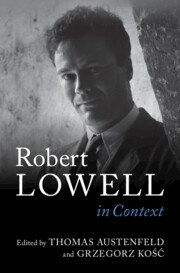Book contents
- Robert Lowell in Context
- Robert Lowell In Context
- Copyright page
- Dedication
- Contents
- Contributors
- Acknowledgments
- Abbreviations
- Introduction
- Part I Places
- Part II American Politics, American Wars
- Part III Some Literary Models
- Part IV Contemporaries
- Part V Life, Illness, and the Arts
- Chapter 16 Religion
- Chapter 17 Marriage
- Chapter 18 Desensationalizing Madness
- Chapter 19 Photography
- Chapter 20 Painting
- Part VI Reputation and New Contexts
- Further Reading
- Index
Chapter 20 - Painting
from Part V - Life, Illness, and the Arts
Published online by Cambridge University Press: 28 March 2024
- Robert Lowell in Context
- Robert Lowell In Context
- Copyright page
- Dedication
- Contents
- Contributors
- Acknowledgments
- Abbreviations
- Introduction
- Part I Places
- Part II American Politics, American Wars
- Part III Some Literary Models
- Part IV Contemporaries
- Part V Life, Illness, and the Arts
- Chapter 16 Religion
- Chapter 17 Marriage
- Chapter 18 Desensationalizing Madness
- Chapter 19 Photography
- Chapter 20 Painting
- Part VI Reputation and New Contexts
- Further Reading
- Index
Summary
Throughout his lifetime, Robert Lowell was intrigued by or even obsessed with the visual arts. It was a preoccupation that started during his school days at St. Mark’s and lasted to the final poem of the last volume he published, “Epilogue,” his ode to painter Johannes Vermeer. This chapter investigates what this passion about especially painting reveals about his writing. Lowell admired and was envious of Old Master painters and sought to emulate their gaze at the world through language. He was more suspicious of photography and contemporary art, although he wrote amply about those art forms as well. By zooming in on Lowell’s creative process and his idiosyncratic revision process of two case studies – “Cranach’s Man-Hunt” and “Misanthrope and Painter” – it becomes apparent that Lowell used the visual arts to consider how he thought about his chosen art form and profession, and how he thought about the world.
- Type
- Chapter
- Information
- Robert Lowell In Context , pp. 216 - 226Publisher: Cambridge University PressPrint publication year: 2024

